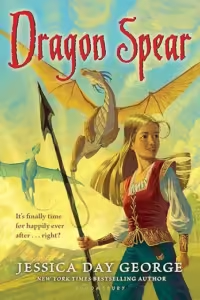Dragon Spear
Jessica Day George
Bloomsbury
Published May 12, 2009
Amazon | Bookshop | Goodreads
About Dragon Spear
The third and final installment in New York Times bestselling author Jessica Day George’s dragon fantasy series races to a dramatic finale.
As far as Creel is concerned, all is finally right with the world. For the first time in centuries it seems dragons and humans might be able to live together in peace. So what better time for Creel and Luka to plan their wedding.
But then the dragon queen, Velika, is kidnapped by a band of rogue dragons in need of a ruler. When Creel and Luka rush to help, they discover that Luka’s father has plans to take back the Far Islands from the dragons. Creel’s happily ever after just might be postponed . . . again.
My Review
Oof. Okay. I really enjoyed the first book in this series, though there are some moments, even in that first one, that I think would benefit from an update. I liked the second book as well, so I decided I would finish the trilogy. (I’m tracking my series reading now, and trying to finish a series when I can.) It didn’t take long before I realized Dragon Spear was going to be a really hard book for me to review due to the problematic content. (See below.)
Each book in the series broadens the world the author has built by exploring other nations and places within it. Each new place has different values and a unique relationship with the dragons who live there. I like the idea of continuing to explore different regions within the world. I wish the story had taken different directions from some of the ones it did take. (See my notes in the representation section below.)
One thing I was interested in seeing the story explore more is the matriarchy of the dragons. In the first book, Creel learns the dragons are led by a queen, and in the second, Queen Velika returns to her people to lead them. In this book, the Creel’s dragons encounter a group of other dragons who enslave humans and make other claims about the matriarchy.
For most of the book, Shardas, the dragon king, leads the dragons, making decisions and forging alliances. Some of the time, Velika is unavailable to make those choices, so it’s clear Shardas stands in her place. But at other times, even though the queen is available, she seems to sit back while the male dragons argue about what to do. It’s possible that I didn’t clearly understand the roles of the queen versus king in the series. I did find myself wishing that the matriarchal rule had been more deeply explored since it would have greatly contrasted the world in which Creel and her other human friends live.
Conclusion
This book wasn’t my favorite in the series, and I think some content would be better removed or revised. In the story, we do get a satisfying conclusion for Creel and Shardas, which is nice. I saw another review in which someone suggested that the author could have included the high notes of this third book as an epilogue in the second book, and I think that’s an interesting idea.
While the writing in the book feels very suited to middle grade readers, some of the content and characters ages make it better suited to older readers. Creel is nearly an adult herself, and busy planning her wedding, for example.
All in all, I’m not sure this is a book I would recommend. I am glad I finished Creel’s journey. Dragon Slippers, the first book in the series, was a lot of fun. It tells a complete story that I think readers could treat as a standalone.
Content Notes for Dragon Spear
Recommended for Ages 10 to 14.
Problematic Content
Creel encounters people described as being primitive and tribal. At first, she believes they have darker skin with white tattoos. She learns the white markings are their actual skin tone, which they preserve by covering the skin with leather pieces while they sleep in the sun. To try to fool the group into believing she is one of them, she darkens her skin. I think this was supposed to come across like a spying disguise, but I couldn’t help thinking that it sounded an awful lot like blackface. The representation of the dragon-enslaved people Creel meets is also problematic and depends on some harmful tropes.
Profanity/Crude Language Content
None.
Romance/Sexual Content
Kissing. A wedding.
Spiritual Content
Creel and the dragon characters discuss the history and lore of the dragons, including practices dating back to the first queen.
Violent Content
Situations of peril. Enemies capture Creel and her allies and hold them by force. A group of dragons enslaves humans, forcing them to do their bidding.
Drug Content
Enemy dragons drug Velika to keep her sedated while imprisoned.
Note: This post contains affiliate links, which do not cost you anything to use but help support this blog. All opinions are my own.
